Contributory members are able to log private notes and comments about each site
Sites Anne T has logged. View this log as a table or view the most recent logs from everyone
Joicey Shaft Cairn
Trip No.141 Entry No.3 Date Added: 1st Jul 2019
Site Type: Round Barrow(s)
Country: England (Northumberland)
Visited: Yes on 30th Jun 2019. My rating: Condition 2 Ambience 3 Access 4
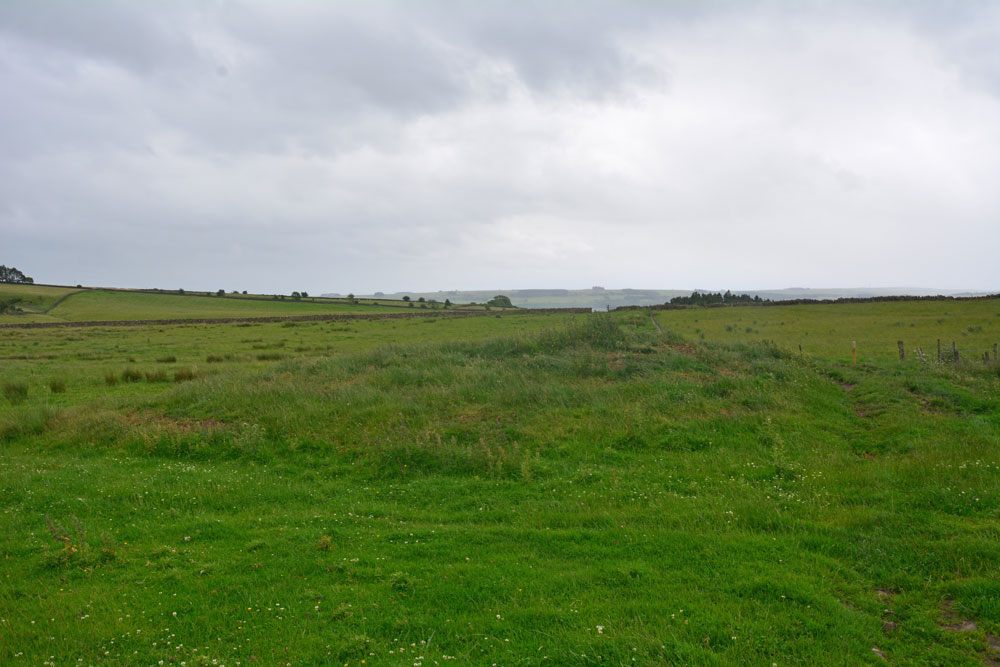
Joicey Shaft Cairn submitted by Anne T on 1st Jul 2019. The cairn as seen from the gate into the field at NY 82860 66456, showing how the farmer has driven his tractor over the western side of the mound, but the track 'bends' away from it, respecting most of the mound.
(View photo, vote or add a comment)
Log Text: Joicey Shaft Cairn: I spotted this mound almost by accident as I was photographing Joicey Shaft B from the track. At first I dismissed it as a manure heap, or possible tailings from the leading mining which used to take place here, but the more I walked round it, the more convinced I was it was a cairn, especially with its proximity to the rock art panels on the opposite side of the track, and because the modern field boundary and the track leading N-S to its western side 'bent' round to accommodate most of the barrow.
It is not recorded by HE or Pastscape, but it is on the old OS maps, so has been here for a while.
Mare and Foal
Date Added: 25th Jan 2016
Site Type: Standing Stones
Country: England (Northumberland)
Visited: Yes on 24th Jan 2016. My rating: Condition 3 Ambience 4 Access 5
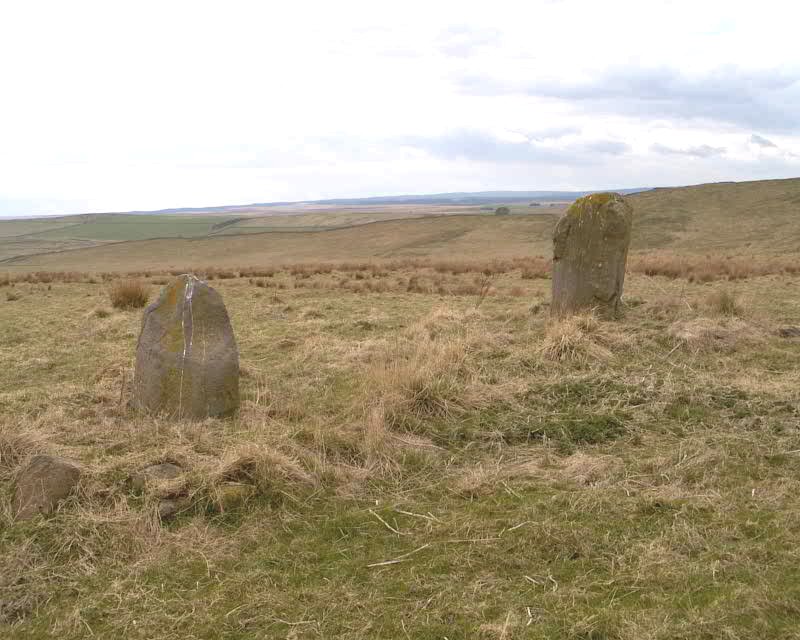
Mare and Foal submitted by spoors599 on 13th Apr 2002. Mare and Foal standing stones, Northumberland.
Landranger Sheet No:86 Grid ref: NY72546632
Located just off the B6318 and close to Hadrians Wall are two standing stones, the larger stone standing 1.51m high, the other 0.98m high at a distance apart of 4.82m. The 1769 Armstrong map of Northumberland marks 3 stones in situ. It has been suggested that the stones formed part of a ?four ? poster?. Loose boulders were packed around the base of the stones to prevent damage by cattle in 1992. The b...
(View photo, vote or add a comment)
Log Text: Mare & Foal Stone Circle, just west of Twice Brewed, Hadrian's Wall: After many months of not being able to get 'out and about', even though the day dawned dull, damp and dreary, it was great to be able to get out into the open countryside again. Strangely, we've driven past this little stone circle on many occasions as we've driven up and down the Military Road (the B6318), but I thought it was just north of Hadrian's Wall. How wrong can you be?
We'd been up into the Edges Green area to try and locate the course of the Roman Aqueduct which wends its way around the contours around here, but it's very difficult to pick out. Anyway, Roman's never did float my boat.
I've wanted to visit this stone circle for ages. We parked at the side of the road leading up toward Shield On The Wall farm. There is no actual footpath here, but it's possible to hop over the wooden fencing where the stone wall adjacent to the B6318 meets the wire fencing which runs northwards up the slope. There were no animals in the field, and the farmer was herding his sheep in the field opposite. I waved and he showed no signs of warning us off.
From the road looking west, it looks as if the stones sit on a low curved mound. The larger stone had a 'bruise' on one side, which in the photographs looked like a cup and ring, but actually seems to be where part of the stone has been broken away.
Smith's Shield Milestone
Trip No.142 Entry No.3 Date Added: 6th Jul 2019
Site Type: Marker Stone
Country: England (Northumberland)
Visited: Yes on 4th Jul 2019. My rating: Condition 2 Ambience 3 Access 4
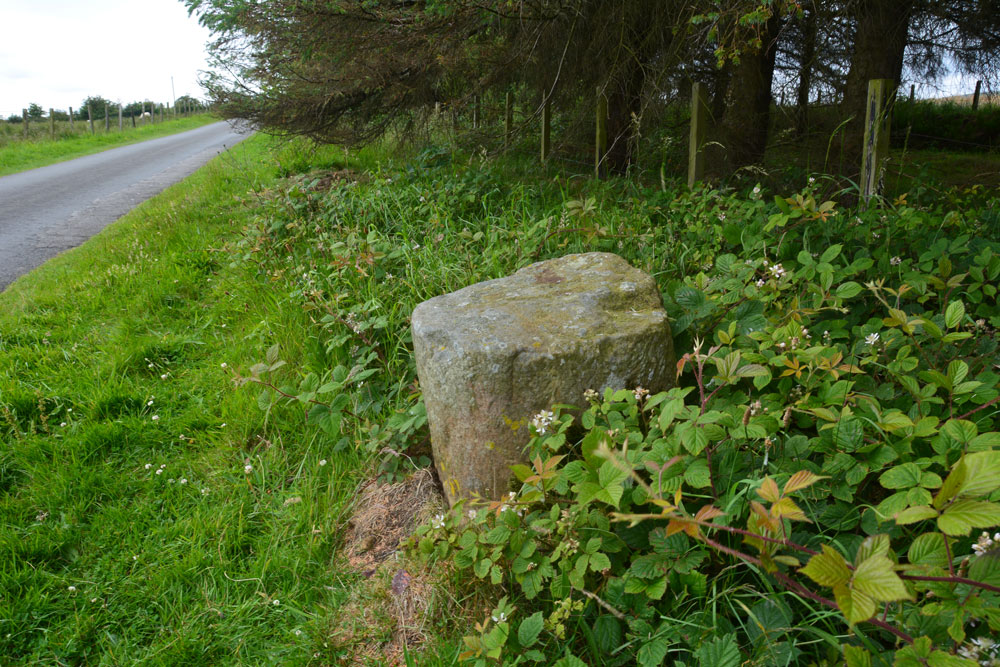
Smith's Shield Milestone submitted by Anne T on 6th Jul 2019. The base of the Smith's Shield Roman milestone, showing its location next to the minor road running east to Vindolanda. It is just over 100m east of the road junction which is just below Smith's Shield farmhouse.
(View photo, vote or add a comment)
Log Text: Smith's Shield Roman Milestone (base of): The base of this Roman milestone, located at the northern side of the road which runs east towards Vindolanda, is easy to spot.
A note of warning to future visitors - we had a run in with the AD122 local bus service who told us off for parking in what he thought was a passing place, but wasn't; there was plenty of room for him to pass, and he parked alongside us before he started yelling. I think he just wanted to shout at someone, but it certainly ruined my day.
There is a second, intact milestone at the eastern entrance to Vindolanda, which we have yet to go back and see.
Prudhoe Castle
Date Added: 12th Apr 2016
Site Type: Rock Art
Country: England (Northumberland)
Visited: Yes on 26th Mar 2016. My rating: Condition 3 Ambience 4 Access 4

Prudhoe Castle submitted by Anne T on 27th Mar 2016. Close up the cup and ring marked stone at Prudhoe Castle. The two larger cups with multiple rings (which appear to overlap) can be clearly seen, if somewhat worn.
(View photo, vote or add a comment)
Log Text: Rock Art @ Prudhoe Castle, Northumberland: I only found out about this stone because I'd been doing some research for the Tynedale North of the Wall Archaeology Group and spotted a record for Prudhoe Castle on the ERA web site (also another one in the Monastic Workshop in Hexham Abbey, which I’ve emailed them about). We’ve lived here for almost 14 years and never been to the castle. I confess to it being prettier than I’d imagined.
Coming up from the Badger Roundabout in Low Prudhoe (junction of the A695 with Station Road), the access road seems pretty tight, although it is wider than it appears. The car park is about 100 yards from the main entrance of the castle. There is a pond to the left of the gate, fed from a stream which is piped under the road from the hillside behind. There are some really nice yew block hedges which really make the entrance. If the trees were out in leaf, you wouldn’t be able to see the castle from the road.
The path climbs gently up the slope, through the gatehouse and under the gatehouse with chapel over. This leads into the outer bailey and immediately in front of you the block with rock art stands against the sloping north wall of the castle, with the ticket office to the left hand side. The sign next to it reads “prehistoric cup and ring marked stone found reused in the footings of a late medieval building on this site.” England’s Rock Art record (ERA-750) tell us that “this stone is very close to the north wall of the castle building (about 0.32m), by a small window. The carved surface faces south to the castle gateway and is in a fairly sheltered position and gets the sun. It was found during excavations of a 14th century hall within the castle. Motifs consist of two, possibly three single cups and two larger cups with multiple rings, the lower cup has three rings and the higher has two, both the outer rings overlap. The rings could be pennannulars, but they’re extremely faint and difficult to make out. Short radial grooves run from the central cups.”
The outer bailey is quite fascinating. When there were no trees (and no toilet roll factory) there would have been brilliant views across the Tyne towards Ovingham.
A footpath runs around the castle in a ditch and we walked round, seeing the foundations of a round tower that once stood. There are the remains of a mill to the left hand side as you leave the gatehouse, with an old mill stone dated 1786 propped by the wall. The old mill leat runs along a paved bed of stones and runs down to the Tyne below.
Chesters Roman Site b
Trip No.142 Entry No.2 Date Added: 7th Jul 2019
Site Type: Rock Art
Country: England (Northumberland)
Visited: Yes on 4th Jul 2019. My rating: Condition 3 Ambience 4 Access 4
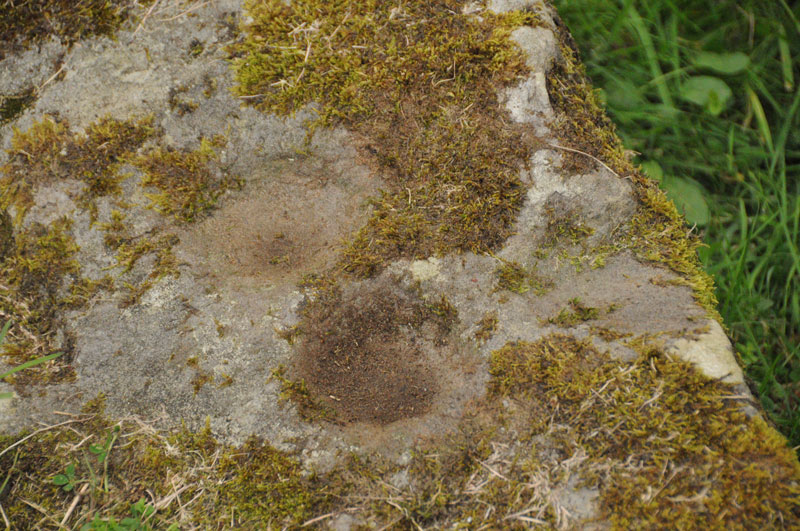
Chesters Roman Site b submitted by Anne T on 1st Sep 2014. Photograph showing two cup marks (0.09m) on stone, with third just on right hand edge.
(View photo, vote or add a comment)
Log Text: Chesters Roman Site b, Chesters Roman Bridge Abutment: Whilst we were here to photograph the bridge abutment, we took the opportunity to look for this panel again to see if it had changed. It was very much the same.
Brecken Hills
Date Added: 13th Apr 2016
Site Type: Hillfort
Country: England (Northumberland)
Visited: Yes on 10th Apr 2016. My rating: Condition 3 Ambience 4 Access 4
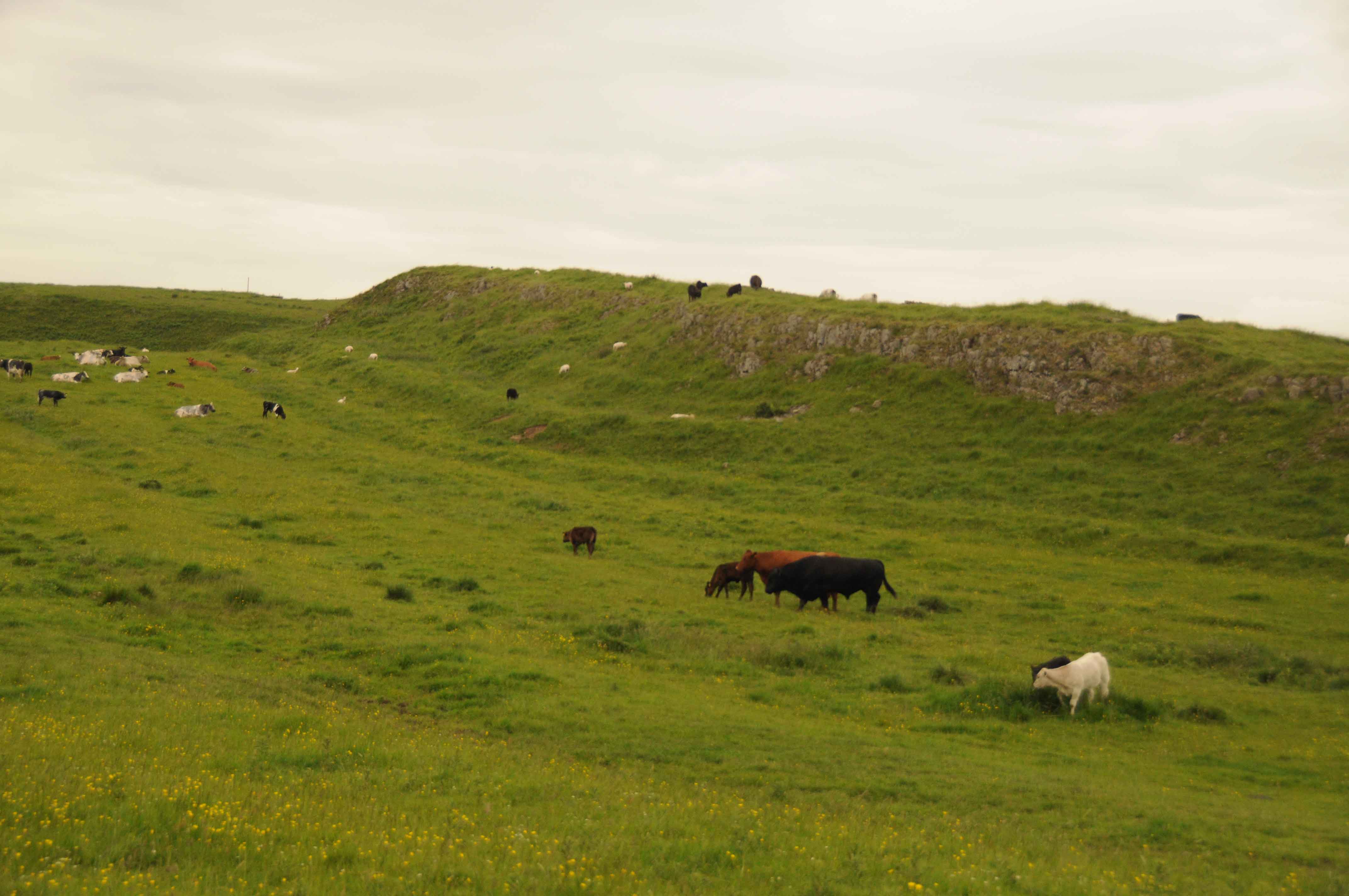
Brecken Hills submitted by Anne T on 17th Jun 2014. Photograph of Blue Crags/Brecken Hills Hillfort showing the rocky incline forming part of the defences on the western edge.
It wasn't possible during our visit to get closer, due to some large bulls and lots of cows with calves, so we thought it wiser not to disturb them.
From the map, the hillfort is extensive, and I look forward to visiting it again.
(View photo, vote or add a comment)
Log Text: Revisit to Blue Crags (Brecken Hills) Hillfort: The last time we visited this site we had to stop at the gate to the field on the Colwell Village side of the site, admiring the outcrop/settlement from a distance. My memory sees at least 3 enormous bulls, feet planted wide, staring at us, daring us to come nearer. Needless to say, we didn't.
This time we approached the site from its northern side, using the public bridleway/access road to Swinburne Quarry from the A68. The HER records (site number N9202) tell me this site covers about an acre and forms a wedge with the whinstone forming natural defensive northern edge and ramparts at the side, the highest part of the site being 600 feet above ground level (although it didn't see that high).
Walking up into the site is easiest from the far edge (near the gate to the footpath to Colwell village), where the site drops virtually to ground level. Walking up the slope to the entrance, a well-preserved hut circle sits to the left hand side of the path. Within the site there are more hut circles - we've never seen such well preserved ones in Northumberland and it was easy to imagine how our ancestors lived and used this space.
The north eastern side of the whin sill has been quarried away, but does not impact upon the site itself.
Well worth a visit.
On the opposite side of the track, to the north, lies the not so well preserved Dunn Crags settlement and enclosure.
Lemmington Wood
Trip No.1 Entry No.1 Date Added: 14th May 2016
Site Type: Rock Art
Country: England (Northumberland)
Visited: Yes on 8th May 2016. My rating: Condition 3 Ambience 4 Access 4
Lemmington Wood submitted by SolarMegalith on 28th Feb 2013. Cup-and-ring marks in artificial lighting (photo taken on February 2013).
(View photo, vote or add a comment)
Log Text: Lemmington Wood Rock Art/Rune Stone, Northumberland: We'd been told about this rock by a member of the Tynedale North of the Wall Archaeology Group who is renowned for visiting many and various rock art sites in Northumberland.
From the A1 North, we turned up on the A697 and drove the almost 16 miles to Edlingham (not to be confused with the nearby village of Eglingham to the north). We arrived in this quiet spot to the sound of a cuckoo in the fields nearby – a sound rarely heard up here these days. Just north of Corby’s Crags, an impressive settlement and rock shelter to the right hand side of the road, there is a turn to the left leading to Lemmington Hall. Just as this side road turns off, there is a small parking area and a memorial bench which looks out over to Edlingham Burn and the Aln Valley.
Whilst these are marked as private woods, there are three trails leading from the entrance gate to the wood. Various signposts say “No Bikes” but doesn’t discourage walkers. The ERA record (see below) says there is open access to this stone. These woods have obviously been decimated by the storms over Christmas and New Year and there are fallen trunks and branches everywhere. The trunks blocking the pathways have largely been chain-sawed to allow access.
A GPS is really needed to find this rock, which sits on the top of a slope, which, if the trees hadn’t been there, would have given great views over the valley beyond. The rock is really hidden in a dip and surrounded by conifers so is difficult to spot.
Someone had been there recently and scrapped off the moss in order to see the rock art and runes more clearly. This was good for us, but not so great for the preservation of these features.
According to the HER records (HER 4471), the runes were only found in 1991 by Ian and Irene Hewitt as they prepared the rock for wax rubbing and photography. The runes and rock art are on the edge and upper face of a 6ft outcrop. Described on the England’s Rock Art site ERA 579.
There is clear evidence on the stone of attempts to quarry it, so what else might have been on a more complete rock?
Jenny's Lantern
Trip No.1 Entry No.2 Date Added: 14th May 2016
Site Type: Hillfort
Country: England (Northumberland)
Visited: Yes on 8th May 2016. My rating: Condition 3 Ambience 4 Access 3
Jenny's Lantern submitted by SolarMegalith on 5th May 2013. Rampart and ditch in the southern part of Jenny's Lantern Iron Age hillfort (photo taken on May 2013).
(View photo, vote or add a comment)
Log Text: From the Lemmington Wood rock art/rune stone, we carried along on the minor roads headings towards the tiny village of Bolton, having gone through the somewhat exciting ford over the River Aln between Abberwick and Bolton Mills, then carried on past Jenny's Lantern Hill to Jenny's Lantern. Despite not having rained for a while, this ford was a lot deeper than it looked!
This site was one of the first we visited at the time we (I) signed up for the Portal. Having tried to find the Midstead Rock Art stones without a GPS, but with many stony outcrops on the hill, we failed, meaning to go back but haven’t until now.
Just east of this hillfort is also a Romano-British settlement, which also includes the remains of an Iron Age defended settlement, with a number of visible hut circles, recorded as HER 4379. The whole site is complex and even with the HER and Historic England records, it is quite difficult to unpick on the ground.
The outer banks and ditches are well preserved. From the road, it’s not easy to see the oval fort at all. There is room for a small car in the gateway to a field to the south, at grid reference NU 12433 15229, overlooking the observatory/listening station at Cloudy Crags to the south east. From the gate in the field opposite, follow the track up the hill then head west almost the field, boundary. On the way to the hillfort you will cross the low banks and ditches of a separate Romano-British settlement. Crossing a stone bank, you will see the eastern outer banks and ditches of the hillfort rising up against the skyline.
The actual Jenny’ Lantern, recorded as HER record 20729 (probably an 18th century’ eye-catcher’ folly) stands north east at the brow of the hill.
The hill fort and settlement sit below the brow of the hill, but there are superb views across to the Aln Valley to the south and west. I'd feel safe living here if I lived in days gone by.
Hadrian's Wall (Heddon on the Wall)
Date Added: 17th Jul 2019
Site Type: Misc. Earthwork
Country: England (Northumberland)
Visited: Yes on 20th Sep 2018. My rating: Condition 3 Ambience 4 Access 5
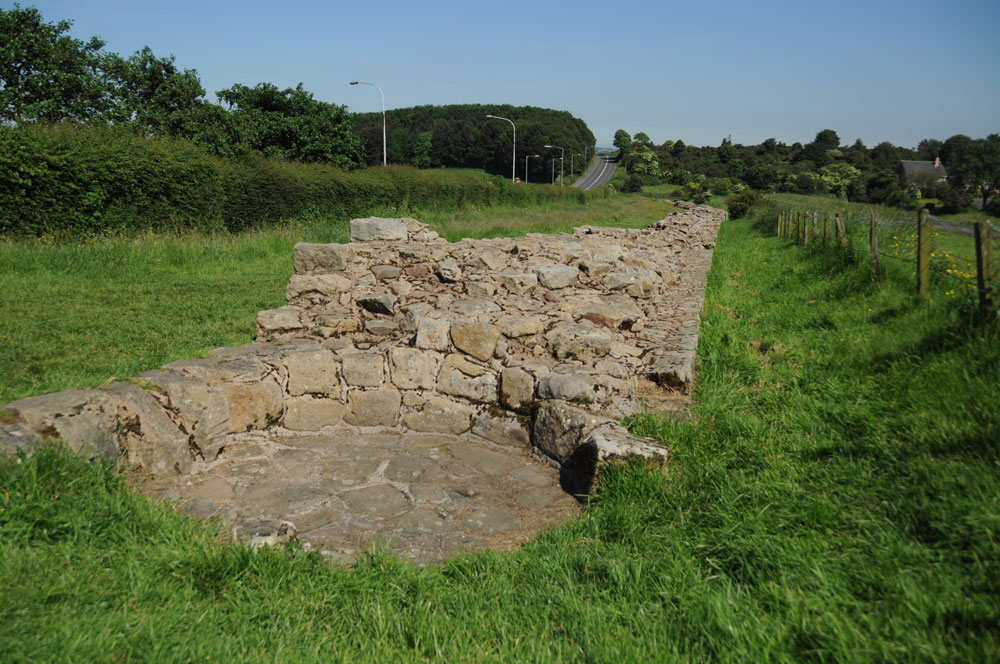
Hadrian's Wall (Heddon on the Wall) submitted by Anne T on 8th Jul 2019. This round structure, built into the body of the wall, is thought to be a medieval corn drying kiln. A creative use of this stone structure! Photo taken 14th June 2014. Looking east down the stretch of wall, with the B6528 running parallel, to the west of the line of the Wall.
(View photo, vote or add a comment)
Log Text: Section of Hadrian's Wall at Heddon-on-the-Wall: This well preserved section of the 'wide' wall can be found a few hundred metres to the east of the church, and comes as quite a surprise as I turned the corner from The Towne Gate, heading east.
There are some structures built into the body of the wall, one said to be medieval corn drying kiln. I saw quite a few tourists passing this spot on the other side of the B6528, but none stopped to walk into this part of the wall and take a closer look.
Midstead 1
Trip No.1 Entry No.5 Date Added: 14th May 2016
Site Type: Rock Art
Country: England (Northumberland)
Visited: Yes on 8th May 2016. My rating: Condition 3 Ambience 4 Access 4
Midstead 1 submitted by SolarMegalith on 11th May 2013. Cup-and-ring mark with a gutter in the NE corner of Midstead 1 panel (photo taken on May 2013).
(View photo, vote or add a comment)
Log Text: After visiting Jenny's Lantern Hill fort and settlement and Midstead 2 and 3 to the west, we walked eastwards along the top of the crag to find the rock art we'd failed to find on our first trip in 2014. Thank goodness for GPS otherwise we never would have found these. The ground in this rocky field had obviously been very wet at some time in the recent past and been home to some large cattle. Not having rained for some time the ground had hardened, making walking over the tussocks difficult. This stone is the most impressive on the hillside with numerous motifs. Well worth seeing. I'm glad we returned. About 3 metres to the south west of this stone we found another with a cup mark at grid reference NU 12424 15448. Having been sent the HER records for Jenny's Lantern, the Historic England map for this entry (1008839) shows a homestead just above the site of this stone - not marked on the OS maps and not clear on the ground (although not being aware it was there we didn't hunt around).
Midstead 2
Trip No.1 Entry No.3 Date Added: 14th May 2016
Site Type: Rock Art
Country: England (Northumberland)
Visited: Yes on 8th May 2016. My rating: Condition 3 Ambience 4 Access 3
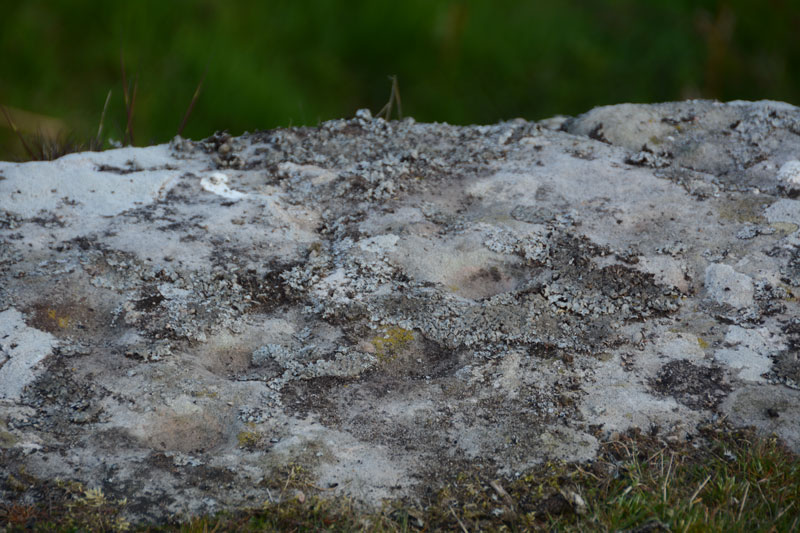
Midstead 2 submitted by Anne T on 11th May 2016. Close up of some of the cup marks on this rock. The ERA-599 record for this stone says there are 35 possible cup marks, but we didn't spot that many. I would have liked to have tried a rubbing of this rock to see how many there were.
(View photo, vote or add a comment)
Log Text: Midstead 2, Rock Art near Edlingham, Northumberland: Having visited Jenny's Lantern Hill Fort and Settlement, we headed back east with the GPS to find the rock art stones we'd failed to find on our visit back in 2014 (our first trip out to find rock art, without a GPS). This rock sits right on the edge of the crag with great views over the Aln Valley below. The cup marks are a little difficult to spot until your eyes adjust to the lumps and bumps on the rock. The cups are inter-disbursed with natural hollows. There are some cup marks on the vertical face of the rock although it was difficult to get too close because of the 'killer' brambles. Note to self: take garden shears/machete on next visit!
Mare and Foal
Date Added: 4th Jul 2016
Site Type: Standing Stones
Country: England (Northumberland)
Visited: Yes on 18th Jun 2016. My rating: Condition 3 Ambience 4 Access 4

Mare and Foal submitted by spoors599 on 13th Apr 2002. Mare and Foal standing stones, Northumberland.
Landranger Sheet No:86 Grid ref: NY72546632
Located just off the B6318 and close to Hadrians Wall are two standing stones, the larger stone standing 1.51m high, the other 0.98m high at a distance apart of 4.82m. The 1769 Armstrong map of Northumberland marks 3 stones in situ. It has been suggested that the stones formed part of a ?four ? poster?. Loose boulders were packed around the base of the stones to prevent damage by cattle in 1992. The b...
(View photo, vote or add a comment)
Log Text: Mare & Foal (2nd visit). We had been up at nearby Edges Green for a geology field day (afternoon) as part of the Tynedale North of the Wall Archaeology Group and had the pleasure of taking one of the members of the group (well known to the Portal, but I don't want to give his name here as I've not asked his permission) up to this small but brilliantly placed stone circle. Parking by the side of the minor road off the Military Road, we went through the gate in the field this time (as opposed to clambering over the wooden fence by the road). The ground was really tussocky and walking was difficult for the first 100 yards or so, having to balance on each one to take a step. Andrew and our guest marched off as if it was level ground, and I felt envious! Whilst there isn't a footpath up to this site, it looked as if other people had also recently walked this way.
Coming up to the Mare and Foal from the north-west the stones clearly sat on a raised bank. In the early evening light, it looked very inviting. Closer up, we could see the area around it had been heavily quarried in a number of areas and it looked as if the stones might have been re-erected judging by the packing around them. Standing just south of the smaller stone, looking north up to Cawfields Gap and the Hadrian's Wall ridge, there is a third, smaller stone buried deep in the grass.
Edlingham Anglo Saxon Cross Bases
Date Added: 7th Aug 2016
Site Type: Ancient Cross
Country: England (Northumberland)
Visited: Yes on 23rd Jul 2016. My rating: Condition 3 Ambience 4 Access 5

Edlingham Anglo Saxon Cross Bases submitted by Anne T on 7th Aug 2016. These two cross bases sit at the south west external side of the church porch. Neither are decorated. Whilst recorded as being 8th century, the HER record queries this date, although they are similar to others of the same date.
(View photo, vote or add a comment)
Log Text: Edlingham Anglo Saxon Cross Bases, Northumberland: We went to visit Edlingham Castle/Fortified Manor House nearby, not expecting to find this charming (but very squat) 11th century church (St John The Baptist). As we approached, I spotted the Anglo Saxon cross bases by the south porch, although nothing is said about these in the church guide. According to the Northumberland HER record, there is also supposed to be the remains of an 8th century cross shaft in the north east corner of the nave, although we didn't spot this during our visit (but is recorded on the AS Corpus).
The location of this church is charming. Within a couple of hundred yards there is the ruined castle, with a wonderful example of a trilobe joggled lintel above the fireplace in the Solar Tower. Beyond is a viaduct from the now dismantled railway. Within easy walking distance is the cup and ring/rune marked rock at Lemmington Wood and the rock shelter at Corby Crags.
Following our visit to the church and castle, we walked to Noah's Well at the eastern end of the village, just outside Demesne.
Five Kings
Date Added: 10th Jan 2017
Site Type: Stone Row / Alignment
Country: England (Northumberland)
Visited: Couldn't find on 1st Jan 2017. My rating: Access 3

Five Kings submitted by Strider on 4th Feb 2003. Five Kings, Northumberland
NT955001
Alignment of four large, irregular stones - the fifth may have fallen but I could not be certain.
(View photo, vote or add a comment)
Log Text: Five Kings, near Grasslees, Northumberland: The easiest access looked as if it was from the footpath near Ovenstone Plantation off the B6341, just past Grasslees. Parking off the road at the entrance to the footpath, we headed off up the track - easy walking at this stage. 100 metres up the track there was a gate/stile with two display boards. Neither bore any similarity to each other, or to the OS map. We had intended walking up the footpath to its fork, 100 metres further up, then take the right hand fork following the stone wall up past The Long Chirn and Woodhouses to the Five Kings. Sadly (presumably being military land) this part of the footpath no longer exists and the walking was difficult (very tussocky, marshy ground). When the heavens opened (despite the weather forecast saying it would be fine!), we contemplated finding a second footpath through Dueshill Farm but it would be dark by the time we reached the stone row, so we decided to go somewhere else and headed back to the car and try another route on a better day. I was so disappointed, as this was a stone row I'd loved to have seen, but the Tosson Tower and Lordenshaw had to suffice for this afternoon.
Lordenshaw Hillfort
Trip No.8 Entry No.1 Date Added: 10th Jan 2017
Site Type: Hillfort
Country: England (Northumberland)
Visited: Yes on 1st Jan 2017. My rating: Condition 3 Ambience 4 Access 4
Lordenshaw Hillfort submitted by DrewParsons on 2nd Oct 2011. View of the second of the two entrances. September 2011.
(View photo, vote or add a comment)
Log Text: Lordenshaw Hillfort, Northumberland: after an abortive trip to the Five Kings stone row, via Tosson Tower Bastle/Tower House, we parked at the main Lordenshaw's car park and headed northwards up the hill towards the hillfort. It was almost 3pm on new year's day and dusk was starting to fall, together with a biting wind and sleet flurries. We've been here before with our daughter and son-in-law on a glorious (but still windy) autumn afternoon, but didn't take any photographs at the time. Wanting to see Channel Rock and other rock art before darkness fell, we didn't linger too long in the hillfort. The defensive banks and ditches are still remarkably clear and the views, particularly down to Rothsbury were great. On the way back from Channel Rock, to the north west of the hillfort, I spotted what looked like cairns. There was an old boundary feature and in the interior of the hillfort, following the pathway to Main Rock, we spotted the stone ring bases of three round houses. Would love to go back on a warm summer's evening!
East Lordenshaw Channel Rock
Trip No.8 Entry No.2 Date Added: 10th Jan 2017
Site Type: Rock Art
Country: England (Northumberland)
Visited: Yes on 1st Jan 2017. My rating: Condition 3 Ambience 4 Access 3
East Lordenshaw Channel Rock submitted by DrewParsons on 2nd Oct 2011. September 2011.
(View photo, vote or add a comment)
Log Text: Channel Rock, Lordenshaw, Northumberland: At the main Lordenshaw car park, there is a display board with a QR reference which I scanned to get me through to the Newcastle University Rock Art Mobile site. This is the first time I’ve been able to use this, as I had a good mobile signal, and found it great.
Their directions to Channel Rock are: “From the top of the hillfort, facing towards Rothbury down the valley, continue through the hillfort to your right. At the waymarked hillfort exit (65m) follow the left hand path. When you reach another waymarker (135m) turn off the path to the right, down the slope. You should see an expanse of white rocks straight ahead (70m).”
We carried on northwards through the hillfort, dropping down the slope to the north, past a waymarker, then headed right. At first difficult to find, as the light grey/whiteish Channel Rock sits within a rocky landscape, once spotted, its easy to identify and sits right on the edge of the hill; the cup marks and channel can be clearly seen.
Nearby is an impressive undercut rock, rounded by water. Brilliant site, sitting well below the crest of the hill/hillfort.
West Lordenshaw Main Rock
Date Added: 10th Jan 2017
Site Type: Rock Art
Country: England (Northumberland)
Visited: Yes on 1st Jan 2017. My rating: Condition 3 Ambience 4 Access 4
West Lordenshaw Main Rock submitted by DrewParsons on 2nd Oct 2011. One of the deep cup and ring marks on this rock. September 2011.
(View photo, vote or add a comment)
Log Text: West Lordenshaw Main Rock, Northumberland: From Channel Rock, we walked back through the hill fort, stopping to admire a possible cairn field and three roundhouses next to the path. Main Rock generally had other visitors around it, but by this time it was starting to get really quite dark and we could spot heavy rain heading to us from across the valley in Rothsbury. I wanted to see both Main Rock and Horseshoe Rock before heading home, but time was too short and we only made it to Main Rock before torches would have been needed to see our way back to the car.
Having also visited the Portal site and seen how many other pieces of rock art there are here, I was regretting loss of our GPS last year on a Level 3 survey with the archaeology group – definitely need to replace it!
Needed to use the flash to get any photographs at this point. Some impressive motifs. Would have liked longer (and warmer weather) to sit and study this rock. A repeat visit (with GPS) to Lordenshaw is on my 'must' list!
Hadrian's Wall (Coria)
Date Added: 3rd Aug 2019
Site Type: Stone Fort or Dun
Country: England (Northumberland)
Visited: Yes on 12th Jul 2015. My rating: Condition 3 Ambience 4 Access 5

Hadrian's Wall (Coria) submitted by Anne T on 3rd Aug 2019. Some of the granary structures in the north western part of the site.
(View photo, vote or add a comment)
Log Text: Corbridge Roman Site: Having lived near here for over 10 years, we'd never visited. We came primarily to see the Corbridge Rock Art panel, but were equally as interested in the well preserved remains of this small fort/town, with great views over to modern-day Corbridge and the Tyne Valley.
Coley's Well
Date Added: 3rd Aug 2019
Site Type: Holy Well or Sacred Spring
Country: England (Northumberland)
Visited: Yes on 13th Jun 2014. My rating: Condition 2 Ambience 3 Access 4
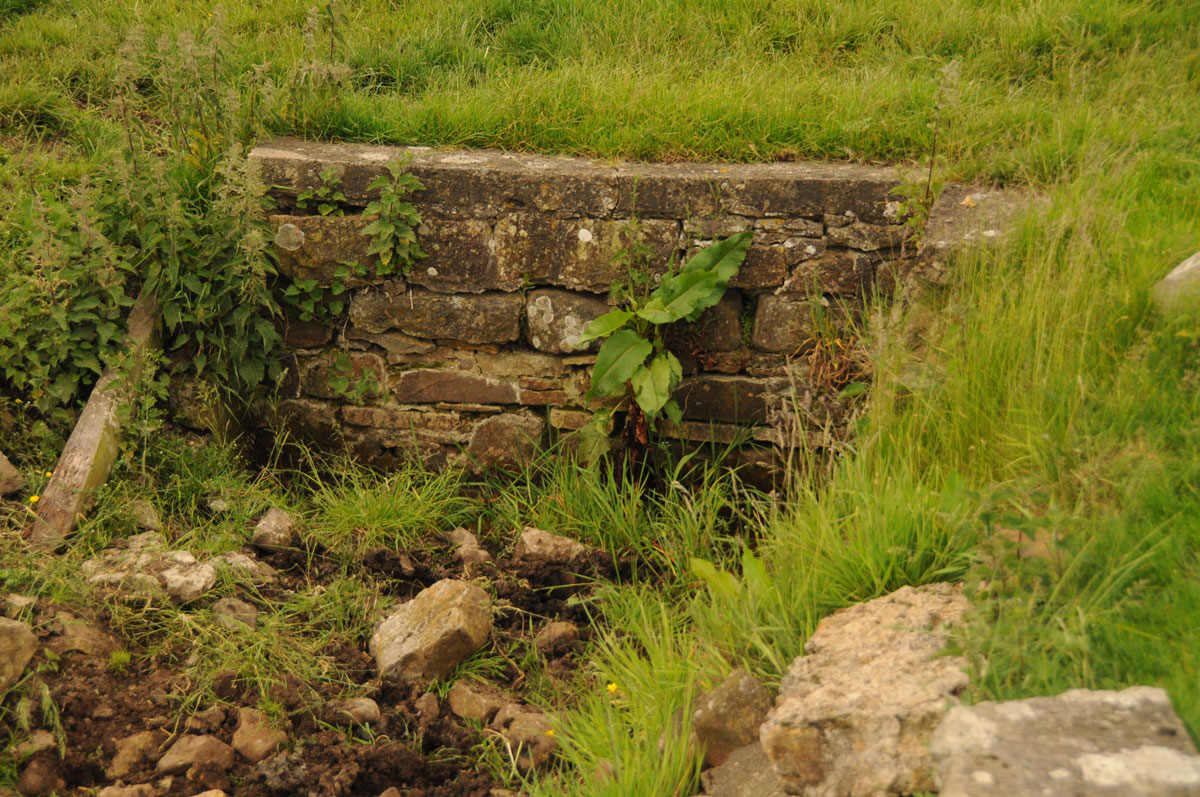
Coley's Well submitted by Anne T on 3rd Aug 2019. A closer look at the ruined back of the well/drinking trough. For a well that used to be known as the Bridal of Colwell and was dressed annually, it is now very sadly neglected. Photograph taken 13th June 2014.
(View photo, vote or add a comment)
Log Text: Coley's Well, Colwell: There is a brick well house close to the houses/farm buildings to the west, although there is also a dry drinking trough/well basin which looked as if this was the original spot where the waters emerged. For a well that used to be called 'Bridal of Colwell' it is now very sadly neglected.
Pricky's Well
Date Added: 3rd Aug 2019
Site Type: Holy Well or Sacred Spring
Country: England (Northumberland)
Visited: Yes on 13th Jun 2014. My rating: Condition 2 Ambience 3 Access 4
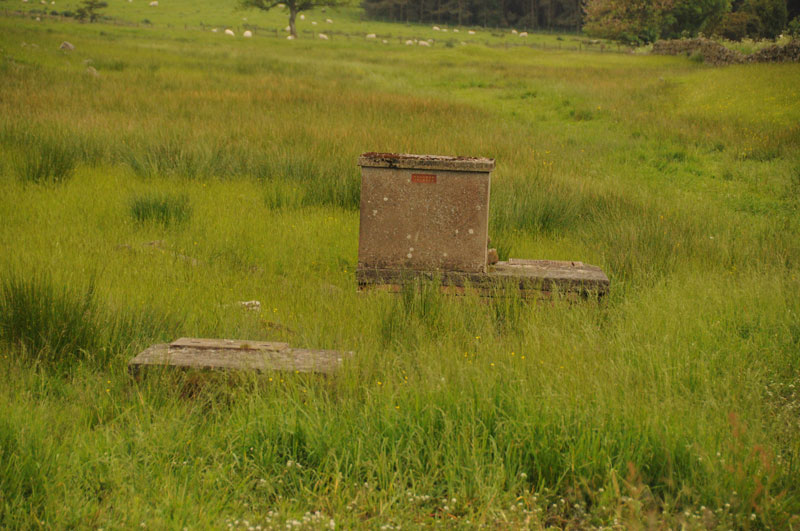
Pricky's Well submitted by Anne T on 4th Sep 2014. Close up of Pricky's Well from the layby by the track to Liddell Hall off the B6342.
(View photo, vote or add a comment)
Log Text: Pricky's Well, Colwell: One of three wells in close proximity in Colwell village. This one sits right by the burn, but is now just a modern brick well house with a wooden door, used to storage some buckets and animal feed inside.
